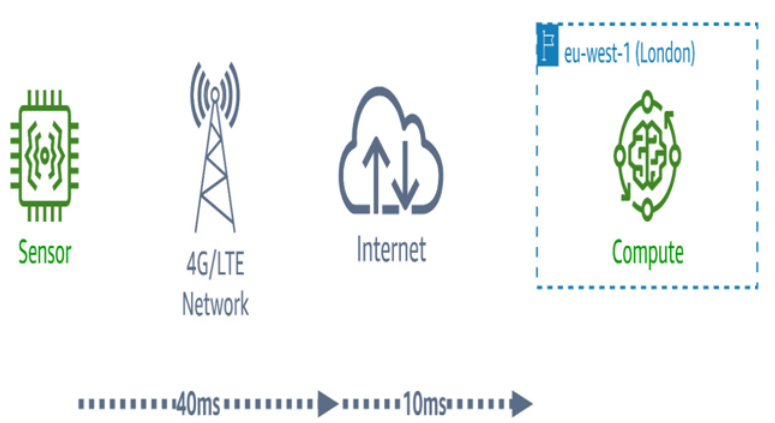Physics – Getting Started with Edge Computing on AWS
The speed of light is fast, but finite – a rule of thumb is to expect a 1 millisecond of latency for every 100 km of distance a signal has to travel. Keep in mind that this is rarely measured in a straight line on a map. The following diagram illustrates a common situation. In this case, a sensor is located in Oxford – just under 100 km from London:

Figure 1.1 – Latency incurred by physical distance and indirect routing
Notice, however, that the latency from the sensor to its compute resources in the AWS region in London is 50 milliseconds, not 1. This is due to the fact that it is communicating over a mobile network using 4G/LTE. The architecture of those networks requires what is known as a backhaul to a central location where the mobile network peers with the internet. Further, due to the vagaries of how data roaming works in 4G/LTE, 40 milliseconds just to reach the internet is not unusual. Then, the packets need to travel across the internet from wherever that central location happens to be to the London region.
Take the example of a cloud-based system that manages and monitors 1 million smart cars. A sensor in a car that can detect a crash is about to occur needs a decision made quickly by a compute resource physically close to it. Waiting for a response from the remote compute in the cloud, approx. 50 milliseconds, may well be too slow. This is especially true if multiple sensors need to send in data for a multivariate decision to be made.
In such cases, physically distributing where that decision is made closer to where the sensors are is the only viable approach.
Economics
Bandwidth can be quite expensive, especially in remote locations. Sometimes, it makes sense to build aggregation points into a system to preprocess data locally before transmitting just the important parts back to a datastore in an AWS region.
Suppose an ML model is being trained on the words people say into microphones in remote locations. A digital recording of a person saying the words “bandwidth can be quite expensive” in M4A format is about 100 KB, while a text file containing those words is only 32 bytes. If all our ML model cares about is the text, we can reduce our bandwidth costs by 3,000-fold by doing that conversion in the field. If the full-sized digital recording needs to be retained, perhaps for legal reasons, it can be queued up on a storage device and physically swapped out once a month as it fills up.
You may also like
Archives
- August 2024
- July 2024
- June 2024
- May 2024
- April 2024
- March 2024
- February 2024
- January 2024
- December 2023
- November 2023
- October 2023
- September 2023
- August 2023
- July 2023
- May 2023
- April 2023
- February 2023
- January 2023
- November 2022
- October 2022
- September 2022
- August 2022
- July 2022
- June 2022
- May 2022
- April 2022
- December 2021
- November 2021
- October 2021
- September 2021
- June 2021
Calendar
| M | T | W | T | F | S | S |
|---|---|---|---|---|---|---|
| 1 | 2 | |||||
| 3 | 4 | 5 | 6 | 7 | 8 | 9 |
| 10 | 11 | 12 | 13 | 14 | 15 | 16 |
| 17 | 18 | 19 | 20 | 21 | 22 | 23 |
| 24 | 25 | 26 | 27 | 28 | 29 | 30 |
| 31 | ||||||
Leave a Reply